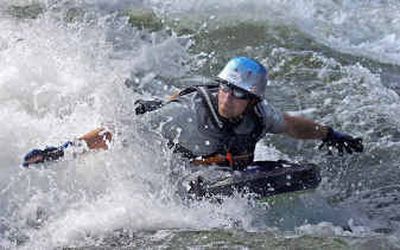River Riders

I might have looked idiotic with my Captain America helmet, frogman fins and farmer John wetsuit, but fashion was the least of my concerns as I stood on the banks of the Clark Fork River near Missoula on a recent afternoon. For some strange reason, I had allowed a friend to convince me that it would be good fun to swim the class II and III whitewater of Alberton Gorge using little more than a chunk of foam. Neither one of us talked much about contingencies or consequences before jumping in. “You freaked?” my friend finally asked, staring at the rapids.
I didn’t answer, but we had one important thing in our favor: Mike Johnston, owner of Montana River Guides and one of the most knowledgeable guides in the country.
Riverboarding has roots as an accidental sport, we had learned in our pre-trip research. The torso-length boards were once only used by whitewater rescuers. They offered nimble, safe passage through big rapids as the riders lay prone and rode them much as a kid might belly-down onto a snow sled.
Training sessions with the boards were incredibly fun and in the mid-1980s a few pioneers began shooting whitewater with the boards solely for the adrenaline rush. One of the pioneers is Bob Carlson, who continues to hand-build the boards from his business near San Francisco.
The boards sell for about $300 and consist of a thick layer of closed-cell foam backed by a sheet of hard plastic. Most of the boards are still sold for rescue, Carlson said, but more people each year are buying them for pleasure cruising.
“It’s kind of like snowboarding in its infancy,” he said.
The learning curve for riverboarding is quick, Carlson said. Most anyone with solid swimming skills is able to surf rapids with less than five minutes instruction. Kayakers can take months to learn the same skill.
“It’s by far the most fun way to go down a river,” he said, adding that riding a riverboard is not unlike driving an expensive sports car, while “taking a raft down a river,” he said, “is like driving a big rubber bus.”
Sometimes, though, there’s nothing wrong with riding in a rubber bus. In fact, I was longing for that sort of stable, dependable vehicle to pull up in front of me as I received final instructions from my guide, Johnston.
I kicked away from the rocky bank with my hands in a death-grip hold on the board’s handles and my elbows planted deep into the foam. Even with the whitewater ahead, I don’t remember hearing anything.
The river seemed much bigger and more powerful at water level.
Johnston led the way through the first rapids. It was a smooth, powerful ride.
The fear was left behind. French and I both wore grins from wet ear to wet ear.
In the gorge’s flat water, we pulled our bodies up on the boards and talked as we floated. Johnston has been offering guided riverboard excursions through the Alberton Gorge since 1994 — it took a while for Johnston to talk his insurance carrier into covering the sport. So far, there’s never been a claim.
“I feel safer on a riverboard than I do on a raft,” said Johnston, who has previous experience as a ranger in Yellowstone and Glacier national parks.
Ninety percent of his clients continue to choose rafts, kayaks and canoes, but each year more are discovering riverboards. Rivers with high flows work best. A four-mile stretch of Alberton Gorge is perfect, Johnston said. The continuous series of rapids makes the river into a veritable playground for the boarders.
During my trip, the Clark Fork flowed at about 2,500 cubic feet per second, which is pretty low. Johnston has ridden the river at 40,000 cfs, which is twice the volume of the Colorado River through the Grand Canyon.
“Didn’t even get my face wet,” he said.
Johnston typically takes only clients 16 and older, but both his children boarded the gorge when they were 5.
Johnston, it should be noted, is perhaps the most experienced swiftwater rescuer in Montana. The state even hires him to train conservation officers. Each of his 15 river guides are required to swim every section of rapids before they take clients in a raft. They are also required to navigate the gorge in a raft without a paddle.
I didn’t ask how that was possible.
I felt comfortable with Johnston, even if my legs and arms were getting a bit tired from all the river action. Each time we approached rapids, my gut did a little flip. I think my genes were trying to remind me that human experiences over thousands of years has shown that messing around in raging river rapids is generally bad for the body.
The last set of rapids, with a honker wave named Fang, was the wildest. Johnston told us to follow his path closely. Big rocks lurked on either side of the narrow chute.
I shot down a giant, curling wave, feeling a bit like a spider being flushed down the toilet.
At the end, a series of high waves launched me and the board airborne. Water injected into my sinuses. I lost track of the shore. I screamed. Then I kicked myself to the bank, pulled myself up onto the rocks and clomped upstream in my flippers with my board on my back.
And I did it again.